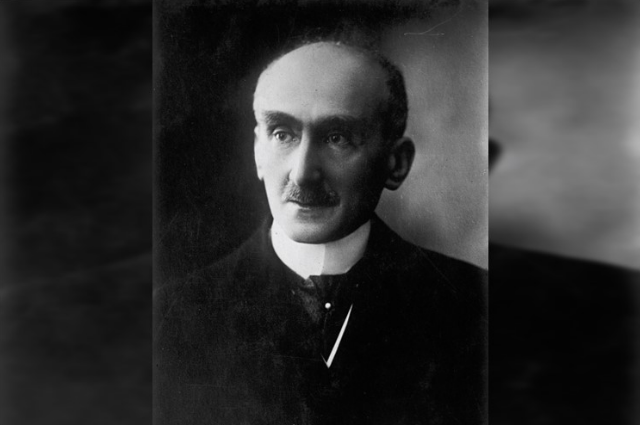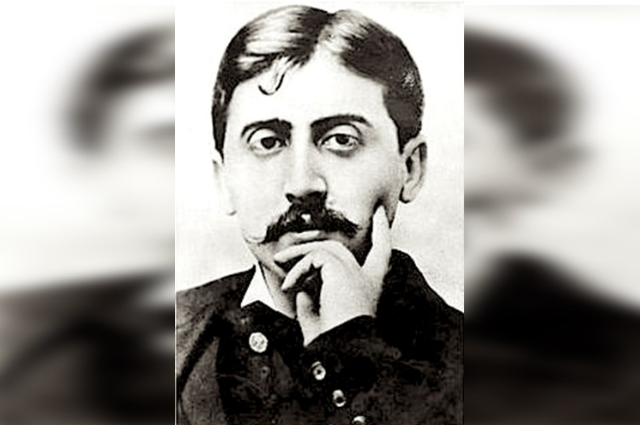Marcel Proust's colossus body of literature, primarily his seven-volume In Search of Lost Time (1913-1927), proliferates and explodes into multiple avenues of meanings and distinct discussions. Its complexity is difficult to grasp because in unspooling the many layers of thread that supply their own disparate and discreet meaning to the text, we often risk getting entangled in a web of convolutions. The non-linear structure of time for instance, or the representation of time as multilayered requires careful detailing and a philosophical understanding of the context that informs the work. Proust also tends to write in a fluid and unbroken flow of language and thought, making him quintessentially modern and therefore very difficult to decipher at times.
He is one of the seminal figures of modern literature and was writing in a period of immense social instability in France. As such his quasi-autobiographical work represents a variety of subject matters like the philosophical discussions of time and memory, the growth of an artist, and the unmasking of the class hierarchy and artificiality of the upper echelons of Parisian society. The Parisian society of the 1920s and 1930s was mired in class divide and through Marcel's recollections of his childhood we get a glimpse of the snobbishness that was prevalent in the high-class Parisian circles.
Proust was born into an upper-class Jewish family and saw many social disruptions including, as Porte writes "the intense collective shock of world war I, and its aftermath". A lot of these events directly or inadvertently affect the shaping of the text in many ways. Proust also discusses the contradictions that underline desire and love, and how they are extremely divergent entities. These discussions were more or less informed by the subjective experiences of the author himself. But there is an element in the text that draws heavily from the then radical and contemporary notion of the durational aspect of time posited by Henri Bergson. Proust adopts this notion in his writings and aided by his fertile imagination applies it to his work and the result is what W. Somerset Maugham calls the "greatest fiction to date." Proust's work has a unique ability to morph itself into a unilateral narrative and then explode into multiplicities of meaning. He packs each sentence with sensory details.
The article will focus on exploring the philosophical character of time and memory as represented in Swann's Way. What Kind of Influence did the concept of la durée have on Proust? And, where exactly within the Proustian schema does this concept fit in? We'll also try and understand how Proust uses seemingly trivial memories as a gateway to the past. And is madeleine more than just a cake?
PHILOSOPHICAL CONSTRUCTION OF TIME AND MEMORY
Through the ages, the notion of Time and Memory has been looked at through a variety of lenses and there’s a rich kaleidoscope of philosophical context that supplies these two notions with their multiple meanings. Proust uses the durational nature of time (la durée) in his exploration of the character of time and memory. Analysis of Proust’s works requires us to be familiarized with an important French philosopher called Henri Bergson. Bergson developed his notions on time in his essay Time and Free Will, in which he sought to improve upon the paucity or the dearth of perceptive ability that he thought was present in Herbert Spencer’s idea of the time which held a more mathematical position on time arguing that time is divisible and quantifiable.

Henri Bergson(1859-1941)
Image by Wikipedia
Bergson indulged in the investigation of a man’s inner life, which according to him was neither a unity nor a quantitative plurality. He theorized that the instant one tried to measure a moment, it would vanish because while one can measure a static, complete line, measuring time is impossible because it is eternally moving and incomplete.
His theory differed entirely from the scientific evaluation of time. He formulated an influential concept of ‘pure duration’ where he argued that “time might well be nothing but a succession of qualitative changes which melt into and permeate one another without precise outlines…without any affiliation with number: it would be pure heterogeneity.” Bergson’s theory left a deep impact on modern fiction and allowed modernist writers to transgress the laws of time and bend them according to their will and the demand of the plot at large. He also talks about time organizing itself like the “notes of the tune” and it being a “qualitative multiplicity with no resemblance to number.” The best literary representation of this strain of thought is found in Proust’s works. Bergson’s theory influenced generations of writers and filmmakers. We see the concept being used in the works of Marcel Proust, Virginia Woolf, and even Russian Filmmakers like Andrei Tarkovsky, whose notion of the ‘sculpting of time’ draws heavily from Bergson’s theory.
The organization of time like “notes of the tune” equates moments in time to something indistinguishable and inseparable from each other. Moments glide in a dynamic and unbroken flow where each moment merges into the other through the process called ‘interpenetration’.
With duration, one can render time historically, summarily, and elliptically, which Proust does in numerous instances in his text, refusing to portray time as strictly chronological by dividing joined moments into independent segments.
This treatment of time opens the text to a plethora of possibilities, which serves to add a nostalgic and ruminative quality to the work. The philosophy of time is an integral structural aspect of the text as well, without which the entire narrative would collapse. Because in the absence of Bergson’s concept of the time, Marcel the novel’s protagonist would have never been able to reconstruct his memory, “historically, summarily and elliptically”, simultaneously, to revisit his bygone days and bring a sense of closure to his past.
REPRESENTATION OF TIME AND MEMORY IN SWANN’S WAY
Marcel abandons the chronological conventions of the time in his work. This allows for a more nuanced and in-depth exploration of moments and memories. It allows him to create slowly wrought plot climaxes and seemingly mundane but very vibrant and meticulous descriptions of time, place, and memory that sometimes span the length of over twenty pages. He even writes long and complex sentences. For instance, a passage from the opening section of Swann’s Way, the description of Marcel’s room, is penned down in an unbroken flow of thought that covers every minute detail, right from how the room was filled with warmth during winters “with the glow of the logs intermittently breaking out again in flame” to sadness that overwhelms him at the thought of not being able to experience the “apparent loftiness of the ceiling” of the Louis XVI room that he feels had been “distinctly reduced” because of time and age.

Marcel Proust (1871-1922)
www.wikipedia.org
Proust through his work seems to attempt to hold back or seize the inevitable and destructive flow of time. The long sentences, the slowly wrought plot climaxes, and the multi-layered representation of time create an apparent halting of movement resulting in inertia which accords a dreamlike flow to Proust’s narrative.
The temporal-spatial relationship serves to invoke memories in the narrative. Proust yokes time and space together with memories to bring out incidents and factors from the narrator’s life that mould his character. The recreation of incidents like the way Marcel longs for his mother’s nightly kiss, which was a kind of ritual for him and the absence of which causes him great discomfort, is brought about through a revisitation of memory. Memory in that sense can outlive time to a certain extent, i.e., as long as the body which experienced them is alive. The moment it starts to decay the memories get atrophied as well.
“Undoubtedly what is thus palpitating in the depths of my being must be the image, the visual memory which being linked to that taste has tried to follow it into my conscious mind.” - Marcel Proust
The famous Proustian Madeleine episode features the “short plump, little cakes”, which within the Proustian world of Combray act as small transportation pods to the past. It subverts time and helps transgress it. It allows Marcel to access and reconstruct the memory of his bygone days. The Madeleine episode also talks about the concept of ‘involuntary memory’, a term that was coined by Proust himself. Involuntary memory can be understood in opposition to voluntary memory. Voluntary memory is characterized by a deliberate attempt to recall the past whereas involuntary memories “are those which are spontaneously brought to consciousness without preceding attempts to retrieve them.” It is a conception of the human memory in which moments of the past are evoked, without any conscious effort, by stimuli encountered in daily life. Marcel’s eating of the madeleine creates a whirlpool that draws him into his past. He is sucked into his childhood and is reminded of the day he was drinking tea with his aunt. In that madeleine, Marcel smells and tastes an entire childhood that is now gone, his mother, his father, and a whole host of characters and incidents that were then lost to the perpetual and unsparing forward-march of time.
The past is hidden somewhere outside the realm, beyond the reach of intellect, in some material (in the sensation which that material object invokes in us) object which we do not suspect.
The madeleine is the object standing between the potential retrieval of the memories and the memories being lost to the chasm of forgetfulness. It helps Marcel transcend time and to a certain extent, death as well. The narrator, Marcel, bemoans the fact that memories are always fragmentary and do not retain the "essence" of the past. But death unlike memory is absolute and is always imminent and hovers around us at all times. Death is not just the physical death of the body, but also entails within it, the death of memories and experiences as well. But Proust transcends death through memory. As long as you are alive in someone else’s memory, a part of you is still alive. Marcel preserves his past and resurrects it through art. Art serves as a preservative, a protective coating for his memories against the devastating, inevitable power of time, that atrophies and erodes everything.
Through the course of the novel we see, Marcel jostle with the invisible antagonist, his veiled and omnipresent enemy whom he can’t see touch, or smell, i.e., ‘time’. “He sat there silent, watching their love expire”. As Marcel gets older, he falls out of love and forgets things, experiences, sorrows, and joys through time. The relentless and destructive march of time makes him old and forgetful. But it is through art, Proust’s colossus seven-volume Remembrance of Things Past, and it's various structural and philosophical elements that he accords a frozen quality to time. His seemingly endless series of descriptions of mundane things conceals a conscious motive to slow time down. The motive is to breathe in, experience, and savour the moment for one last time as Marcel, the narrator is being slowly consumed by time. The novel is his last stand against time, to preserve his memories from being eroded.
. . .
WORKS CITED:
- Proust, Marcel. “Swann's Way”. Trans. C.K. Scott Moncrieff. 1992. Chatto & Windus, 1913. February 2023. Digital File.
- Hembrough, Dr. Tara. "Proust Configures Time, Space, and Memory to Unveil Marcel's Artistry in Swann's Way." International Journal of Language and Linguistics 5 (2018). February 2023. Digital File.
- Bergson, Henri. “Time and Free Will: An Essay on The Immediate Data of Consciousness”. Trans. F.L. Pogson. 1910. Mead Project, 1899. February 2023. - https://brocku.ca.
- Porte, Rebecca Ariel. thebrooklyninstitute.com. n.d. 13 February 2023. - https://thebrooklyninstitute.com
